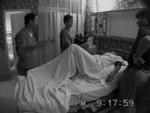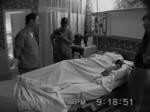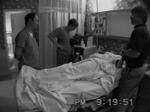Part I.2 Extra-ordinary times
To clarify the above, we examine in some detail one of the times when the group discusses Lonnie's possible level of pain and what might have to be done about it. While it might be common sense to assume that she initiates this conversation, it is better analytic sense to stay with the fact that most of the actors directly participate in the discussion. Lonnie's own contribution is somewhat ambiguous. At times she appears to be asking for more pain killers as others suggest that her pain is not quite so bad and that what she has received is enough, given the evidence provided by the monitor. At still other times, she appears to be warning the anesthesiologist not to take her too seriously given that she has a history of lying about the pain.
The anesthesiologist has come to check on his patient half an hour after administering the epidural. The visit starts with greetings and a joking remark about how about the level of support she is receiving.
| frame # | Wife | Husband | Anesthesiologist | Researcher | seconds |
|---|---|---|---|---|---|
| 9:17:50 | ~ ~ | ~ ~ | ~ ~ | ~ ~ | 0 |
 |
~ yeas | ~ ~ | Mr and Mrs McD? ~ | ~ ~ | 1 |
| ~ ~ | ~ ~ | How are you? | ~ ~ | 2 | |
| ~ ~ | ~ ~ | ~ ~ | ~ ~ | 3 | |
| ~ ~ | ~ ~ | ~ ~ | ~ ~ | 4 | |
| ~ ~ | ~ ~ | ~ ~ | terrible ~ | 5 | |
| ~ ~ | ~ ~ | ~ it doesn't | ~ ~ | 6 | |
| ~ ~ | ~ ~ | look too good you're | ~ ~ | 7 | |
| ~ ~ | ~ ~ | ~ ~ | ~ ~ | 8 | |
| xxx ~ | ~ ~ | they are all all | ~ ~ | 9 | |
| 9:18:00 | ~ they are | ~ ~ | comforting you ~ | ~ ~ | 10 |
| (FULL TRANSCRIPT II: Seconds 9:15:51 to 9:18:24) | |||||
A few more exchanges establish a basic evaluation of what is happening: the pain is less and Lonnie can still move her legs. This appears to satisfy the anesthesiologist but Lonnie, though she agrees that the pain is indeed less, pushes him to give further assurances about the future. This escalates into a statement about not having experienced any pain in her earlier labors, a statement apparently challenged as the anesthesiologist mentions the difficulties she experienced in these labors:
| frame # | Wife | Husband | Anesthesiologist | Researcher | seconds |
|---|---|---|---|---|---|
| no, in my other labors | ~ ~ | ~ ~ | ~ ~ | 57 | |
| ~ ~ | ~ ~ | ~ ~ | ~ ~ | 58 | |
| I didn't feel any pain | ~ ~ | ~ ~ | ~ ~ | 59 | |
| 9:18:50 | ~ yeah | ~ ~ | really? ~ | ~ ~ | 60 |

|
~ ~ | ~ ~ | ~ the | ~ ~ | 61 |
| ~ ~ | ~ ~ | one with the forceps | ~ ~ | 62 | |
| ~ ~ | ~ ~ | and the ~ | ~ ~ | 63 | |
| ~ ~ | ~ ~ | in the O.R. and | ~ ~ | 64 | |
| ~ ~ | ~ ~ | what was the other one? | ~ ~ | 65 | |
| [GENERAL ********* LAUGHTER] | 66 | ||||
| (FULL TRANSCRIPT II: Seconds 9:15:51 to 9:18:24) | |||||
The statement about not having felt "any pain" appears to raise the local stakes but in a way that is taken by all as an occasion for humor, not drama. Lonnie enters in the laughter and she continues with a long narrative, possibly allowed by a question from the anesthesiologist that could have been taken rhetorically and thus not in need of an answer. This narrative is centered about a small "amusing" anecdote about a Chinese anesthesiologist would count not say "clamp," pronouncing it instead "cramp," and concluding with an account of how she was completely numb when the time came to push, and thus could not push, had to have a Cesarean section, and couldn't move her legs for several hours. This reminds everybody of the fact that she had in fact tricked the anesthesiologist into giving her twice the dosage she should have received. The following lines constitute the collectively performed "punch line" which contains what remained the overall identification of Lonnie during this labor:
| frame # | Wife | Husband | Anesthesiologist | Researcher | seconds |
|---|---|---|---|---|---|
| 9:19:42 | I'm telling you ~ I was | ~ ~ | ~ ~ | ~ ~ | 112 |

|
in the recovery room for | ~ ~ | ~ ~ | ~ ~ | 113 |
| five hours ~ | ~ ~ | ~ ~ | ~ ~ | 114 | |
| numb ~ they brought me | ~ ~ | ~ ~ | ~ ~ | 115 | |
| back I thought I was like | ~ ~ | ~ ~ | ~ ~ | 116 | |
| never going to walk again | ~ ~ | ~ ~ | ~ ~ | 117 | |
| [GENERAL ********* LAUGHTER] | 118 | ||||
| I had so much ~ | ~ ~ | she is dangerous you know | ~ ~ | 119 | |
| 9:19:50 | ~ ~ | she is dangerous because | ~ ~ | ~ ~ | 120 |
| ~ !******! | she'll keep asking for it ~ | ~ ~ | ~ ~ | 121 | |
| (FULL TRANSCRIPT II: Seconds 9:15:51 to 9:18:24) | |||||
Lonnie is now affirmed by all to be "dangerous" and this allows all to question her assessments of her pain. Her laughter, and the fact that she does not challenge this identification, is particularly noteworthy.
The following talk confirms that she does not challenge the identification. The narrative has ended but the anesthesiologist continues with a general question about the number of children Lonnie has. The anesthesiologist talks about his children and they discuss the wisdom of having several children close together. Then Lonnie goes into a contraction. The anesthesiologist checks on its progression off the monitor and gives his identification: "right off the Richter scale, Lonnie ~ ~ ~ practically breaking the chart." Lonnie looks at the monitor and agrees "all right, I feel better." The anesthesiologist gives her advice about how she should move in the bed given the catheter in her back, and then leaves.
The story about the earlier labor, as well as the talk about familial demographics, fit within the unmarked times between contractions when talk always ranges widely. But the story is clearly more than chitchat in its reception and in the way it continues to be used, along with other preceding comments, continually to reconstruct that in the word that all laugh with, Lonnie is "dangerous." This identification is redundantly marked as something special that all must take into account. This is not quite a normal "third labor" because the laboring woman has a currently relevant history of endangering herself and her child by overemphasizing her pain. This is not only a matter of distantly past behavior. Lonnie talked about her fear of pain during all the pregnancy checkups Cotter observed, and she continues talking about it throughout the labor. Before we return to this issue, we should note that the episode reveals the extent and form of Lonnie's activity as a possibly somewhat resistant patient. She may not be in control of the telling of her body. But she has not surrendered to the experts either. She is actively at work within the framework of the labor, using doctors and machines, not to mention her body, possibly against themselves. Anesthesiologist and husband, in return, take her activity into account as they disagree with her assessments. All treat the body as an external object to which no one, not even Lonnie, have full or "unalienable" rights. Temporarily at least, the body has been alienated from all participants, objectified as it become an occasion for an interactional struggle.

